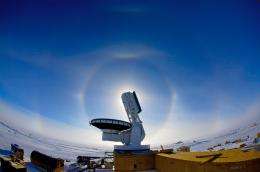Studying Matter and Radiation from the Early Universe

(PhysOrg.com) --Almost 400,000 years after the universe was created in the big bang, matter cooled sufficiently for neutral atoms to form, thereby allowing the pervasive light to propagate almost completely unhindered.
Today, that light bathes the universe. We see it as the cosmic microwave background radiation (CMBR), and modern instruments study it intently to try to determine what happened right after the birth of the cosmos. Among other things, the light holds clues into how stars and galaxies subsequently formed and evolved. Galaxies tend to gather in clusters -- our own Milky Way galaxy, for example, and its local group of neighboring galaxies are at the edge of the Virgo Cluster.
The intergalactic gas within clusters of galaxies is sometimes heated by shocks as it falls into the galaxies. That relatively dense, hot matter can scatter the primal light of the CMBR -- billions of years after the light was set free. Astronomers have been trying to search in maps of the CMBR for slightly fainter regions due to this effect, known as the Sunyaev-Zel'dovich Effect (S-Z Effect) after the theorists who first proposed its existence in 1970. In recent years, several groups have attempted to discover clusters of galaxies using the S-Z effect. Clusters found this way are interesting in themselves, and they also have valuable statistical properties for studies in cosmology.
CfA astronomers and a large international team of their colleagues have just published a landmark series of six observational papers on the S-Z Effect and related phenomena using results from the South Pole Telescope, a ten-meter-diameter submillimeter telescope located at the Amundsen-Scott South Pole station in Antarctica. Tony Stark, ChrisStubbs, Mark Brodwin, Ryan Foley, Andrea Loehr, Brain Stalder and Matt Ashby contributed to some or all of these papers.
The S-Z Effect itself was seen in twenty-one clusters of galaxies so far, sufficient to yield preliminary tests of cosmological models. Besides helping to confirm models of galaxy formation in the early universe, it has enabled the astronomers to refine parameters of the big bang cosmology. The telescope has also detected and characterized 188 distant galaxies, and determined that 75% of them emit millimeter-wave radiation characteristic of galaxies dominated by massive black-holes at their nuclei, while the other 25% are dominated by dust emission from star formation. The team concludes that these latter objects represent the rarest and brightest members of the class of very early galaxies in the process of formation.
Other papers in this important series present an analysis of the variations in the CMBR itself, and optical distance measurements of the newly discovered galaxy clusters. The set of papers is an important advance in our understanding of the early universe, both of its matter (as seen in galaxies) and its radiation (as seen in the CMBR).
Provided by Harvard-Smithsonian Center for Astrophysics

















